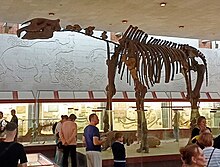Rhinocerotoidea
Appearance
| Rhinocerotoids, Ceratorhines Temporal range: Latest Paleocene-Present
| |
|---|---|

| |
| A Black rhinoceros (Diceros bicornis) at the Saint Louis Zoo | |

| |
| Skeleton of Paraceratherium (Paraceratheriidae) | |
| Scientific classification | |
| Domain: | Eukaryota |
| Kingdom: | Animalia |
| Phylum: | Chordata |
| Class: | Mammalia |
| Order: | Perissodactyla |
| Suborder: | Ceratomorpha |
| Superfamily: | Rhinocerotoidea Gray, 1821 |
| Families | |
Rhinocerotoids are ceratomorphs belonging to the Rhinocerotoidea superfamily consisting of four families of odd-toed ungulates, three of which ceratorhines, the Amynodontidae, Hyracodontidae, and Paraceratheriidae, are extinct. The only extant family is the Rhinocerotidae (true rhinoceroses), which survives as five living species. Extinct non-rhinocerotid members of the group are sometimes considered rhinoceroses in a broad sense. The family Paraceratheriidae contains the largest land mammals known to have ever existed.[1]
Taxonomy
The cladogram below follows a phylogenetic analysis by Bai et al. (2020):[2]
| Rhinocerotoidea |
| ||||||||||||||||||||||||||||||||||||||||||||||||
| (sensu lato) |
References
- ^ Deng, T.; Lu, X.; Wang, S.; Flynn, L. J.; Sun, D.; He, W.; Chen, S. (2021). "An Oligocene giant rhino provides insights into Paraceratherium evolution". Communications Biology. 4 (1): 639. doi:10.1038/s42003-021-02170-6. PMC 8211792. PMID 34140631.
- ^ Bai, B.; Meng, J.; Zhang, C.; Gong, Y.-X.; Wang, Y.-Q. (2020). "The origin of Rhinocerotoidea and phylogeny of Ceratomorpha (Mammalia, Perissodactyla)". Communications Biology. 3 (1): 509. doi:10.1038/s42003-020-01205-8. PMC 7490376.
